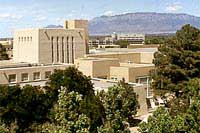
I am switching gears from mass transportation and going back to UNM. I believe the state and city have come to understand the importance of the universities to their regions. Tech transfer is something that TVC has been pushing for about a decade now. This is all great, we even have a Science and Technology Park near the Eubank gate to Sandia Laboratories as a shining example of those efforts. However, once again, I go back to the neighborhoods around UNM. Even with some of the city's most expensive homes per square foot in the city, the university still maintains a moat-like boundary around itself as though to separate itself.
Attending a meeting for the "Great Streets" initiative last evening, someone made a very valid comment; why had the city paid HDR great sums of money to create such a plan? Does the city not believe that our highly-touted School of Architecture has the knowledge to get the job done? Is this not the exact type of project the students in the Community and Regional Planning program would love to gain experience in? Furthermore, what about the city planners? Are they too busy catching up with permitting?
Setting an example, once again an out of state school has stepped up its effort to enhance the environment of its surrounding neighborhoods. Here is an excerpt from "The Planning Report":
"When President Sample arrived 14 years ago he said that he wanted USC to be a leader in its local community. And, while he talks about Los Angeles and the Southern California region, he specifically wanted USC to become a good, responsible neighbor for residential communities around our University Park campus and our Health Sciences campus.
He drew an imaginary circle that encompasses the neighborhoods in about a seven to ten block radius and said that USC would focus its resources and its work within this area. He wanted to embark on initiatives that would increase the educational attainment of the children in the area, help provide employment for the adults in the area, and increase the safety of children going to and from their schools, parks, etc.
We’re also going to support local and minority businesses and help them grow and thrive as entrepreneurs. We work every day on these initiatives to make the neighborhood and therefore the university even greater."
All I can say is I'm envious. It doesn't take anything extraordinary, just collaboration.